Assassin’s Creed III: Liberation Review (Vita)
- Updated: 20th Nov, 2012
Aveline is a monster. Should you ever find yourself sharing a town or even a swamp with this woman, get the hell out of there. Fast.
Liberation may share an engine and a time period with Assassin’s Creed 3, yet the tone of this game is vastly different. Where Connor (and Ezio and Altaïr) are discouraged from wantonly killing innocent civilians, Vita protagonist Aveline has no such compunctions. In fact, you’re required to kill innocent bystanders if you wish to stay anonymous. I suppose that to a woman of African descent in a city beset with slave traders, few people are really innocent?
Dress in Style and Go Hog Wild
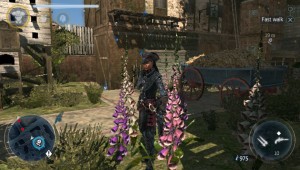 The biggest difference between Connor and Aveline (besides the obvious) is her guises. As a black noblewoman of sorts in 1700’s New Orleans, Aveline can slip in and out of three different personas – the Lady, the Slave and the Assassin.
The biggest difference between Connor and Aveline (besides the obvious) is her guises. As a black noblewoman of sorts in 1700’s New Orleans, Aveline can slip in and out of three different personas – the Lady, the Slave and the Assassin.
Of course, a slave would never be allowed to wear a proper gown, nor would a lady be seen carrying her own goods, so each persona carries its own level of notoriety. At level one, guards will eye you suspiciously. Reach level two and they’ll confront you quickly. At level three they’ll attack on sight and with fewer blending opportunities than the Ezio trilogy, this will seriously impede your progress.
Dressing as a slave allows you to slip past guard posts by carrying crates but you can only carry your hidden blades. You’ll gain notoriety by doing such mundane things as accidentally grabbing a wall by running too fast but you’re the most easily hidden, with plenty of opportunities to grab a brush and get street-sweeping with your fellow scum slaves. Should you attract too much attention by, perhaps, inciting a riot or simply walking across a balcony in a funny way, posters will appear around the city for you to tear down, as per the previous AC games.
The assassin outfit gives you notoriety level one simply by wearing it. On the other hand, this guise gives you the full range of movement and a full arsenal so the occasional suspicious look is easily dodged by nipping behind a chimney. Getting the guards to look the other way is expensive though, costing thousands of écu in bribes, the probably-fictional currency used in Liberation.
Aveline wears her Lady’s outfit to run her family’s trading business. As befitting a lady of that stature, she wears a hoop skirt, which makes it impossible to climb or race through the streets.
Rich women are seen as easy prey by the city’s muggers. Should she venture down the wrong alleys, Aveline will be expected to totter her way over to the guards for help. Killing an attacker by herself – even after luring them down an empty alley – will raise her notoriety and create witnesses who apparently managed to see the commotion from street level, through a fence and two buildings. You’ll have to murder these “witnesses” if you want the guards to continue treating you as a reputable member of society.
Scarily, these murders are incredibly easy. In several memory sequences you can walk straight up to a witness, stab him in the back and walk away as his cronies don’t bat an eyelid. Later sequences require more subtlety but by then you’ll have poisons to do your dirty work from a respectable distance.
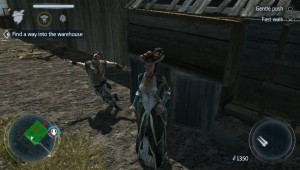 The guises could have made for some really creative solutions to missions, but that’s not really the Assassin’s Creed way. Instead, you’ll often find yourself restricted to the single costume that allows you to experience the memory the correct way.
The guises could have made for some really creative solutions to missions, but that’s not really the Assassin’s Creed way. Instead, you’ll often find yourself restricted to the single costume that allows you to experience the memory the correct way.
This makes sense in the context of the game but feels like a missed opportunity to allow us players some freedom. Equally, striving for full synchronisation rarely gives you any more insight into the memory. Optional objectives are more about killing with the right weapon or not taking any damage. It’s an incentive purely for completionists.
Pole the Pirogue
You’ll spend a fair amount of the game in the bayou, the boggy wetlands outside New Orleans. Like Connor, you’ll be swinging through the trees in search of encampments, hidden treasures and other such repetitive fetch quests, though you won’t be doing any hunting.
I found that the monstrous trees in the bayou were the most interesting and varied of the viewpoint challenges, compared to the rather bland tower climbing that has plagued the cities in recent years. Rather thankfully, the viewpoint synchronisation camera doesn’t suffer from the crotch-fixation issue seen in ACIII. It’s just a pity that the viewpoints will show you either foggy trees or foggy seas.
Compared to the people-filled city streets, it’s lovely to run free through the bayou and stalk your smuggler prey from above. A fair whack of the main plot takes place here too – it’s not just a free-roaming wilderness – and that’s when it starts to get a little frustrating. Running through the treetops is quick and easy but if you’re searching for alligator eggs or other things off those pre-made paths then you’ll do a lot of slow wading through boggy muck and navigating around unassailable 6-foot hillocks.
You could also canoe from islet to islet if you’re feeling particularly masochistic. This is nothing like the smooth canoeing action of Uncharted: Golden Abyss where you stroke the left and right sides of rear touchpad and Drake responds with the appropriate paddle. Aveline is a clumsy rower and switching hands is difficult for her. You’re better off skipping the rear touchpad entirely and just using the X button to row yourself into the many awkwardly tight spots. Or stick to the trees.
While canoeing with the touchpad is bad, worst implementation of a Vita feature was rolling a ball through a maze in Mexico. The game failed to calibrate the gyroscope correctly. When I tilted the Vita left, the ball went up. Tilting it up sent it right.
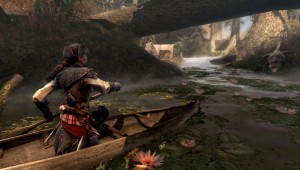 Sure, it was easy once I figured out what was wrong but that was after 20 rage-inducing minutes of careful, failed rocking, as well as shutting the game down and starting it again in the hopes that the puzzle would recalibrate. No such luck.
Sure, it was easy once I figured out what was wrong but that was after 20 rage-inducing minutes of careful, failed rocking, as well as shutting the game down and starting it again in the hopes that the puzzle would recalibrate. No such luck.
Goodbye Joe, Me Gotta Go
Assassin’s Creed III: Liberation is “published” by Ubisoft and Abstergo. As such, it’s a tool for providing Abstergo’s point of view on events. I was disappointed to find that I never got to delve much into Aveline’s character journey, nor play Aveline’s modern-day descendant. Fans of the science-fiction aspects of the series will find some references to the struggle between Templar and Assassin, but nothing on the scale of ACII or Brotherhood.
The multiplayer is equally thin. You choose a faction – Abstergo or the Assassins – and battle to control nodes across the world in asymmetric warfare. Each week, the number of control points owned by each faction is tallied up and rewards distributed accordingly.
You never actually control the battles, just send in an agent with or without powerups to battle one of three opposing agents by way of virtual background dice rolls. I’ve not played much – my agents all seem to need 30 minutes to recharge after a battle, which means I get 3 minutes of gameplay followed by 4 hours of forgetting the mode exists followed by another 3 minutes of gameplay.
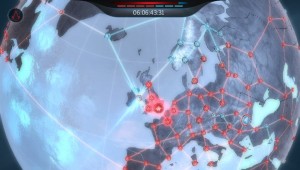 Liberation is a little buggy, especially in the early sequences. I found guards appearing on my map that weren’t visible until they suddenly popped into existence right next to me and tailed NPCs developed the ability to see through walls.
Liberation is a little buggy, especially in the early sequences. I found guards appearing on my map that weren’t visible until they suddenly popped into existence right next to me and tailed NPCs developed the ability to see through walls.
As with all the games, the economy is nonsensical. The optional side quests to take out Aveline’s family business’s opponents and buy up their shops gives you a hefty discount on weapons and clothing colours but it’s easy enough to complete the entire game with just your hidden blade and a few smoke bombs.
The trading minigame in your headquarters is another time-constrained diversion, where you choose items to trade and send ships around the world, hoping not to lose your cargo to pirates or storms. Come back in 30-90 minutes to find out if you’re rich or have lost all your money. Again, there’s no real depth here. Prices don’t change if you flood the market and you can’t insure your cargo against disaster or to anything to prevent loss. It’s basically a really slow form of gambling.
Son of a Gun, We’ll Have Big Fun
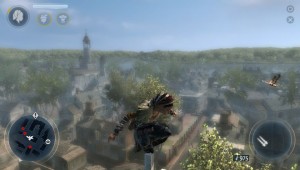 The core of the game, however, is enjoyable. You’ve plenty of chests to find, plenty of smugglers to murder and a whole bunch of slaves to free. The guises add enough of a difference that’s it’s not just Assassin’s Creed III Lite while at the same time, it’s very much Assassin’s Creed III Lite.
The core of the game, however, is enjoyable. You’ve plenty of chests to find, plenty of smugglers to murder and a whole bunch of slaves to free. The guises add enough of a difference that’s it’s not just Assassin’s Creed III Lite while at the same time, it’s very much Assassin’s Creed III Lite.
You’ll spend plenty of time climbing, running around rooftops and killing, but many of the extras are thin. Collectible alligator eggs have no impact of the rest of the game and the side quests can be cleared up in a matter of hours.
Liberation may not have the depth of its console counterparts but it’s absolutely worth playing. Unfortunately, it’s currently priced around £40, the same as its console counterpart, and the frustrating touch design bugs make that very difficult to justify. If you’re really hankering to run around rooftops while on the go and you have money to burn then go ahead. You’ll have fun. For everyone else, I’d advise waiting for the price to drop.
Assassins Creed III: Liberation is out now on PS Vita and from the PlayStation Store


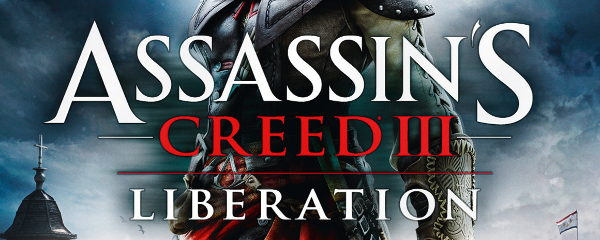
Follow Us!